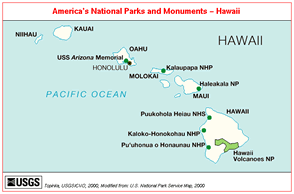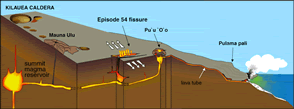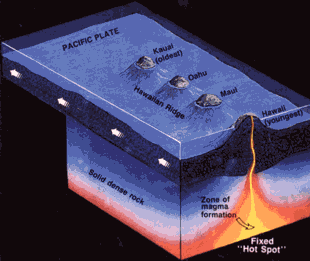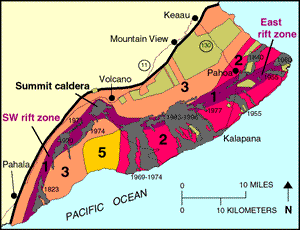Kilauea Volcano Hawaii
Volcano Learning Zone > Volcanic eruption Casestudies >Kilauea Volcano Hawaii
Kilauea is one of the worlds most active volcanoes and famously erupts riversof lava down its slopes. Situated on Big Island in Hawaii it is also one of the worlds most visitor friendly volcanoes. You can even see lava flowing into the sea sometimes.
Where is the volcano?
 Kilauea is located in the south of the Big Island within the Hawaii Volcanoes National Park. Kilauea sits on the shoulder of Mauna Loa and the summit is only 1247m (4091ft). There are no steep cinder cone slopes here as this is a shield volcano and slopes are very low angled and gentle due to successive lava flows. Kilauea has been active for 23,000 years and has been continuously erupting since 1983 ; 90% of the volcano is less than 1,100 years old. The summit caldera is around 11 miles in circumference and contains the Halema'uma'u crater (active 1974), the home of Pele, and the Kilauea Iki (little Kilauea) crater which was active in 1959. The floor of the caldera contains lava flows from the 1970s and 1980s, the most recent being lava from 1982.
Kilauea is located in the south of the Big Island within the Hawaii Volcanoes National Park. Kilauea sits on the shoulder of Mauna Loa and the summit is only 1247m (4091ft). There are no steep cinder cone slopes here as this is a shield volcano and slopes are very low angled and gentle due to successive lava flows. Kilauea has been active for 23,000 years and has been continuously erupting since 1983 ; 90% of the volcano is less than 1,100 years old. The summit caldera is around 11 miles in circumference and contains the Halema'uma'u crater (active 1974), the home of Pele, and the Kilauea Iki (little Kilauea) crater which was active in 1959. The floor of the caldera contains lava flows from the 1970s and 1980s, the most recent being lava from 1982.
The Pu'u' oo ( "Poo-oo Oh Oh") vent on the southern slope of the volcano ,along the south eastern rift zone,is the site of current activity and first became active in 1983 with lava fountains 460m high.
When has Kilauea erupted?
Kilauea first emerged from the sea floor aorund 500 000 years ago as the next in the Hawaiian chain of volcanoes. There have been 61 historical eruptions with the oldest dated rocks being 23,000 years old. Since 1952 there have been 34 eruptions and Kilauea has been erupting continually since 1983. Firstly with the eruption of Pu oo oo vent and now from the Kamoamoa Fissure which erupted in March 2011 generating 2.5million cubic mets of lava/day. In 1990 the the towns of Kalapana and Kaimu were totally destroyed by lava flows from the Kupaianaha vent plus a long stretch of Route 130,the coastal road, which now abruptly dead-ends at the lava flow.50 ft of lava covers the towns. Homes have also been destroyed in 2008,2010 and 2011. In March 2008 the summit crater of Halema'uma'u produced its first explosive event since 1924, showering the summit area in debris and causing the closure of roads to tourists. In 2011 the crater has a lava lake within a collapsed section of the cater floor.
Why is there a volcano here?
 Hawaiian volcanic activity is due to a Mid-ocean Hot Spot or mantle plume firing a jet of hot rock at the base of the Pacific Ocean crust over the past 70million years to form the Hawaiin-Emperor Semount chain . The jet of hot rock punches a hole through the crust and creates a volcano which eventually emerges from the ocean as an island. As the Pacific plate has moved to the NW over the Hot Spot at a rate of 5-10cm /year , islands have moved away from the Hot Spot and new volcanic islands have been created. The older volcanic isalnds erode until they become coral atolls and eventually dissapear beneath the waves to become sea mounts. The entire chain is 5000km long the oldest sea mount being near the Aleutian trench near Alaska and the youngest volcano is Lo'ihi , which is still submerged off the coast of Big Island( Hawaii Island).
Hawaiian volcanic activity is due to a Mid-ocean Hot Spot or mantle plume firing a jet of hot rock at the base of the Pacific Ocean crust over the past 70million years to form the Hawaiin-Emperor Semount chain . The jet of hot rock punches a hole through the crust and creates a volcano which eventually emerges from the ocean as an island. As the Pacific plate has moved to the NW over the Hot Spot at a rate of 5-10cm /year , islands have moved away from the Hot Spot and new volcanic islands have been created. The older volcanic isalnds erode until they become coral atolls and eventually dissapear beneath the waves to become sea mounts. The entire chain is 5000km long the oldest sea mount being near the Aleutian trench near Alaska and the youngest volcano is Lo'ihi , which is still submerged off the coast of Big Island( Hawaii Island).
Eruption Style
Hawaiian volcanoes erupt basaltic lava which has low viscosity and erupts at around 1000C. Most eruptions are gentle effusive lava flows which can travel far from the vent. Spectacular lava fountains can also be produced, as in the Kilauea Iki eruption of 1959 which reached 320m high.
Hazard Management
 The volcano is monitored by the United States Geological Survey(USGS) who have an observatory on the Kilauea crater rim. Lava flows are the main volcanic hazards and VOG- volcanic gases mixing with clouds or steam. Lava flows are currently flowing from Kilauea but it is Mauna Loa which poses the biggest risk to the largest settlement in the South- Hilo.Currently lava flow hazard areas are mainly on the south and south east coast. Hawaii is also prone to tsunamis which originate from around the Pacific Ring of Fire . Tsunamis from Chile (1960), Alaska (1949/64) and Japan.The Pacific Tsunami Warning Centre is located in a volcanic crater on Oahu. Key to map here.
The volcano is monitored by the United States Geological Survey(USGS) who have an observatory on the Kilauea crater rim. Lava flows are the main volcanic hazards and VOG- volcanic gases mixing with clouds or steam. Lava flows are currently flowing from Kilauea but it is Mauna Loa which poses the biggest risk to the largest settlement in the South- Hilo.Currently lava flow hazard areas are mainly on the south and south east coast. Hawaii is also prone to tsunamis which originate from around the Pacific Ring of Fire . Tsunamis from Chile (1960), Alaska (1949/64) and Japan.The Pacific Tsunami Warning Centre is located in a volcanic crater on Oahu. Key to map here.


